It was the most sensational shooting in Fort Worth since Luke Short and Jim Courtright had gotten crossways with each other outside the White Elephant Saloon twenty years earlier and four blocks farther north.
And just as in that 1887 shooting, on March 22, 1907 a gambler and a saloon were involved.
 Tarrant County Attorney Jefferson Davis McLean, at age thirty-six, had spent his adult life in public service. He had been elected mayor of Mount Pleasant at age twenty-one. After moving to Fort Worth in 1895 he had served as assistant to County Attorney James Swayne. McLean’s father, William Pinckney McLean, had been a congressman and district judge (McLean Middle School is named for the father).
Tarrant County Attorney Jefferson Davis McLean, at age thirty-six, had spent his adult life in public service. He had been elected mayor of Mount Pleasant at age twenty-one. After moving to Fort Worth in 1895 he had served as assistant to County Attorney James Swayne. McLean’s father, William Pinckney McLean, had been a congressman and district judge (McLean Middle School is named for the father).
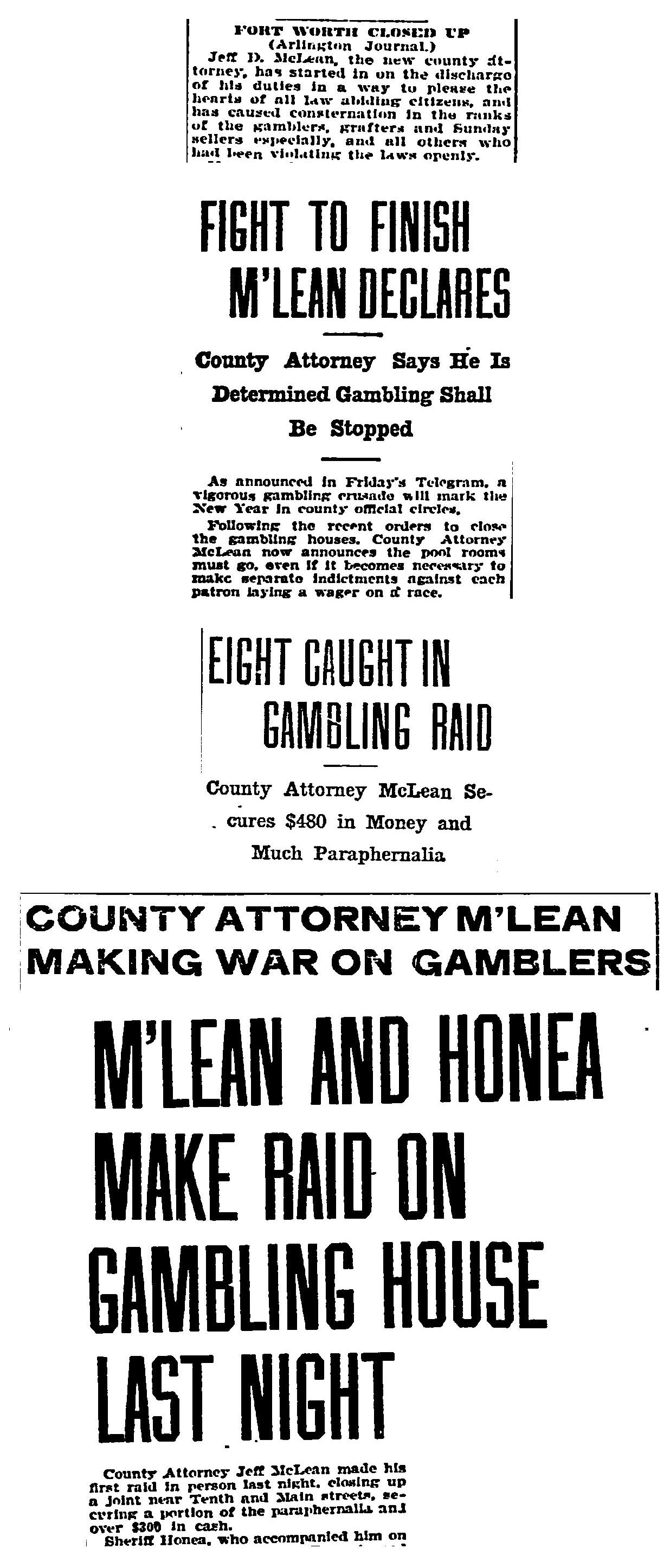 Elected county attorney in 1904 and reelected in 1906, Jefferson Davis McLean was a savvy politician. He knew the value of headlines. Headlines showed that he was fulfilling his campaign promise to close the gambling joints of Cowtown.
Elected county attorney in 1904 and reelected in 1906, Jefferson Davis McLean was a savvy politician. He knew the value of headlines. Headlines showed that he was fulfilling his campaign promise to close the gambling joints of Cowtown.
March was Stock Show time. Thousands of visitors were in town. And McLean had timed some raids on saloons and gambling rooms to coincide. His target on March 22: Bill Thomason’s room.
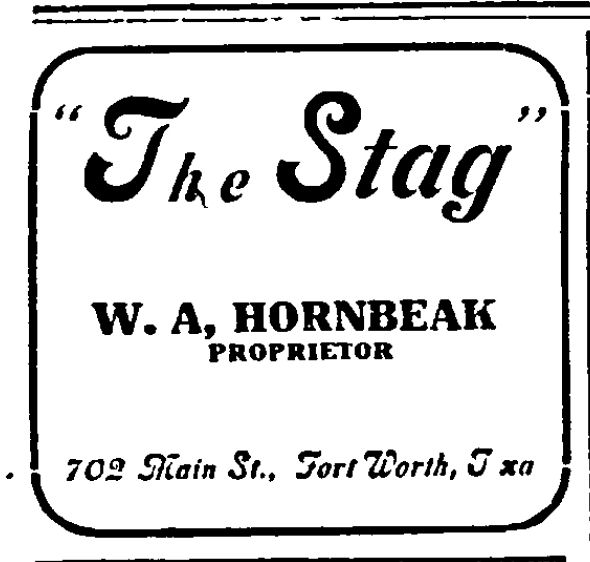
Just as Luke Short had been proprietor of the gambling room over the White Elephant Saloon at 308 Main, Bill Thomason was proprietor of the gambling room over William Hornbeak’s Stag Saloon at 702 Main Street. Bill Thomason was no Luke Short, but he was described as “well-known gambler and man-about-town” by the Fort Worth Telegram. Likewise, the Stag was no White Elephant, but it also was no Hell’s Half Acre dive. The Stag was a decent watering hole where men could drink downstairs and gamble upstairs. Gambling was illegal, but over the years local law enforcement had often winked at gambling and other forms of vice.
Then came Jefferson Davis McLean. He was not a winker. He didn’t have wink one in his head. Jeff McLean was a reformer. And relentless. He often personally participated in the raids he ordered. In fact, on March 22, 1907 he took along his brother, his wife, and County Commissioner Duff Purvis. It was to be a routine raid on a Friday afternoon, but it might steal some headlines from the Stock Show.
The raid upstairs over the Stag began routinely enough. Sheriff Tom Wood and his deputies arrested a few gamblers and began confiscating Bill Thomason’s gambling equipment. Then the McLean party arrived. Jeff McLean left his wife waiting in their buggy a half-block away and walked to the Stag to oversee the final stages of the raid.
Bill Thomason, forty-three, had just one arm but a chip on each shoulder. And he carried a .45 revolver in his one hand. Someone at the courthouse had tipped him off that his gambling room was to be raided. Thomason had already been raided once that week. For the law to raid him again so soon, he reasoned, was not playing fair. After the second raid began, he showed up at the Stag to protest as officers loaded his gambling paraphernalia onto a wagon. Thomason saw McLean, cursed at him, then drew his pistol and shot McLean in the neck. Thomason escaped into an alley behind the saloon as witnesses raised the alarm.
Jeff McLean was carried to R. A. Anderson’s drugstore two doors down from the saloon. McLean died in his wife’s arms.
Railroad special officer Hamil Scott, age forty-two, was returning from the Stock Show with his wife when he came upon the commotion at the Stag. Scott drew his pistol and soon was leading a crowd of people in pursuit of Thomason. Thomason ducked down an alley between Throckmorton and Houston streets and concealed himself. As Scott came down the alley, Thomason ambushed him, shooting Scott twice. And then two more times. Thomason then took Scott’s pistol and fled.
Soon after McLean had been shot, a rumor had circulated among members of the crowd gathering at the Stag: Thomason had been captured and was in jail at City Hall. The crowd moved from the Stag to City Hall and demanded the key to the jail. A jailer allowed two men from the crowd to search the jail. In reality Thomason was still at large and three blocks north. He had disappeared into the A. J. Roe lumberyard at Throckmorton and West 7th streets.
Police officers Dennis Loyd and Ben Bell, hearing that Thomason was seen running into the lumberyard, began to hunt for him among the stacks of lumber. Thomason was cornered. As the crowd around them swelled, Thomason and the two policemen exchanged gunfire. Thomason was hit once by each officer.
After Thomason was transported to the jail at City Hall, a crowd around City Hall grew to an estimated three thousand. Extra policemen were positioned around the perimeter of City Hall lest the crowd devolve into a mob. There was talk of lynching. At first Police Chief James Maddox tried to calm the crowd members by telling them that Thomason was dead. The crowd didn’t believe him. Later Maddox told the crowd that Thomason was dying and that there was no need for lynching.
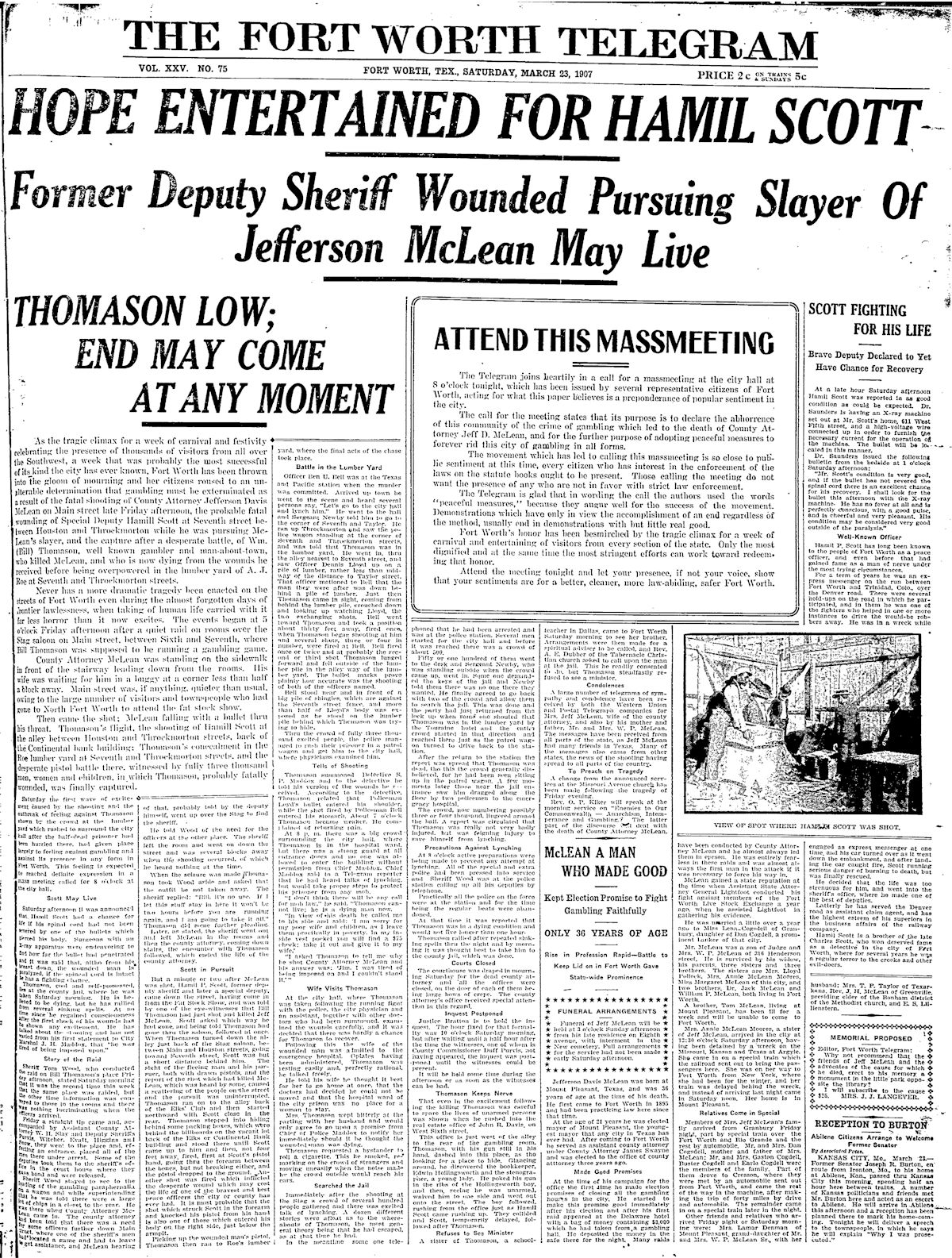

Just thirty-five minutes after McLean was shot, the Telegram published the first of three extra editions, which combined sold eleven thousand copies in a city with a population of sixty-eight thousand. Some newsboys on the street sold almost one thousand copies each. In the next day’s regular edition all of page 1 and most of page 2 were devoted to the triple shooting.
Maddox spoke with Thomason as the prisoner lay in the jail infirmary. Why had Thomason shot McLean? Because, Thomason told Maddox, he was “tired of being imposed upon” by law enforcement raids.
A few hours later Thomason died.
 McLean and his killer, the Telegram noted, were buried “a short distance” apart at Oakwood Cemetery. (McLean was reburied in Mount Olivet Cemetery in 1948.)
McLean and his killer, the Telegram noted, were buried “a short distance” apart at Oakwood Cemetery. (McLean was reburied in Mount Olivet Cemetery in 1948.)
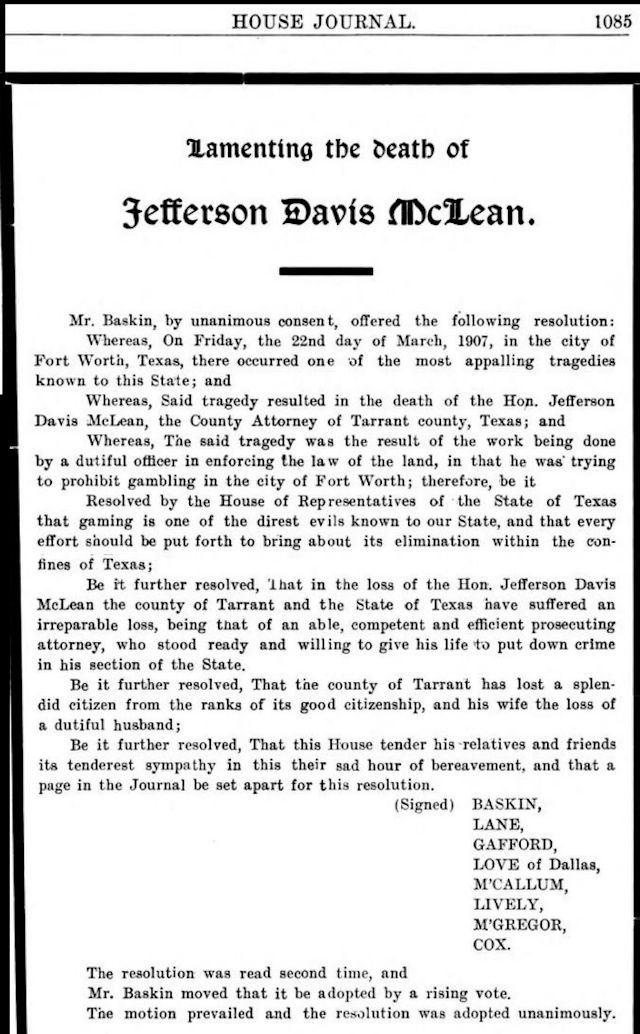 The Texas House of Representatives passed a resolution honoring McLean.
The Texas House of Representatives passed a resolution honoring McLean.
 On March 31 the Telegram published a letter from Bill Thomason’s widow.
On March 31 the Telegram published a letter from Bill Thomason’s widow.
Meanwhile, Hamil Scott was paralyzed, a bullet lodged in his spine. Dr. Bacon Saunders, dean of Fort Worth Medical College and owner of the almost-completed Flatiron Building, used a newfangled technology, the X-ray, to locate the bullet. But the damage was irreparable.
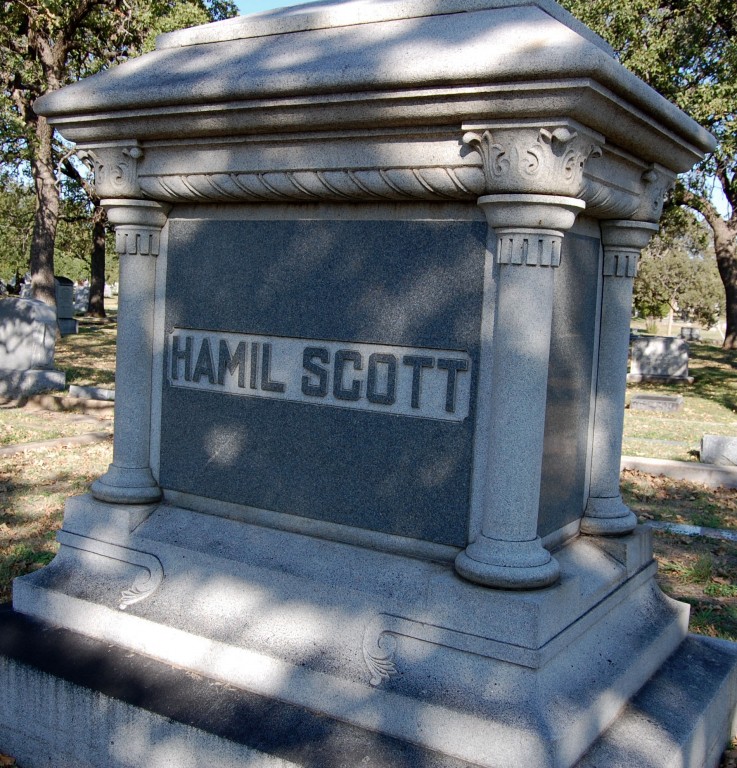 On May 1 Hamil Scott died, becoming the third fatality of March 22. He, too, was buried at Oakwood.
On May 1 Hamil Scott died, becoming the third fatality of March 22. He, too, was buried at Oakwood.
Three days later the widow of Bill Thomason died of natural causes and joined the other three at Oakwood.
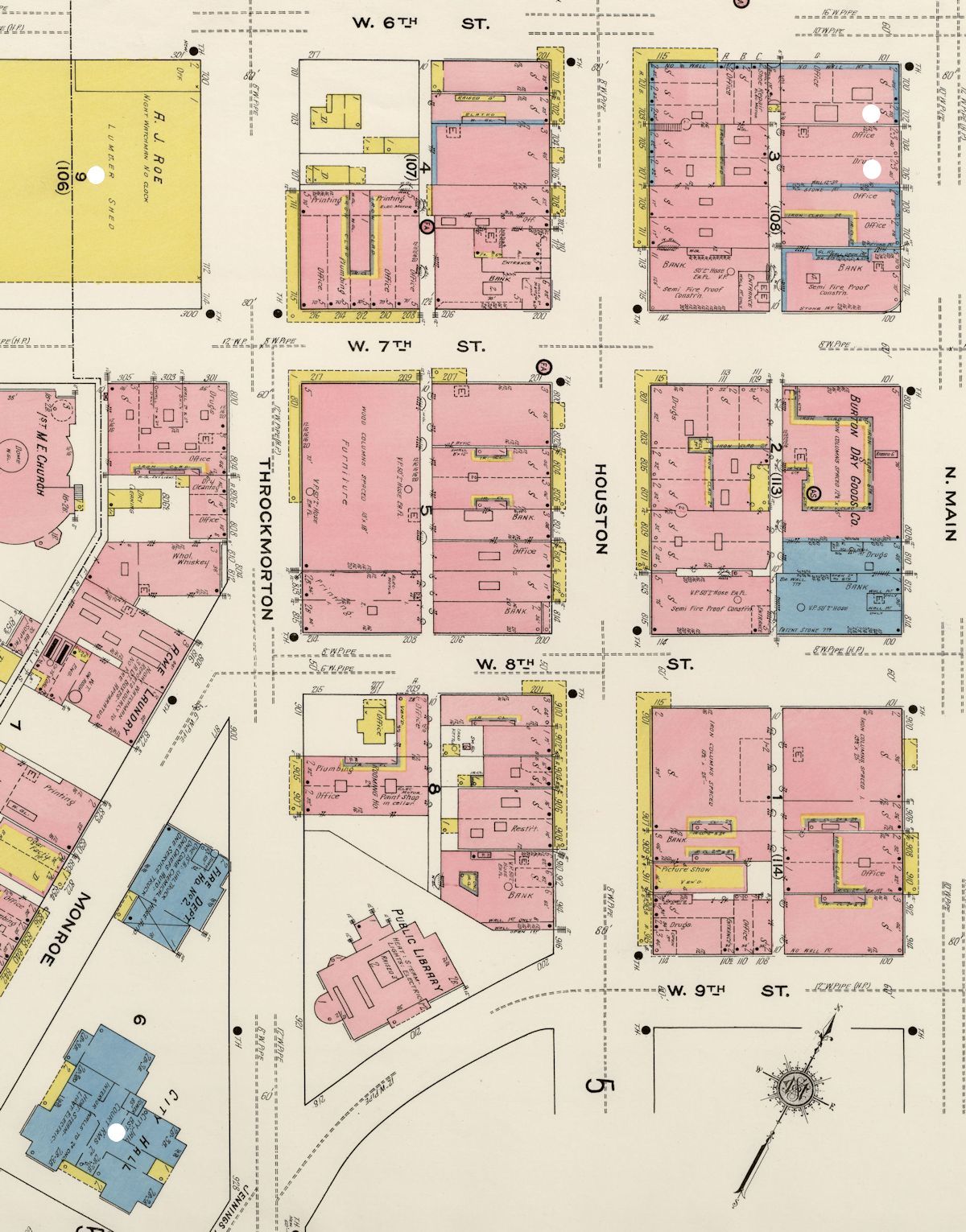 Four white dots on this map show the principal locations of the crime. The Stag Saloon where McLean was shot and the drugstore where he died on Main Street were located in the upper right; the Roe lumberyard (future location of the Fort Worth Club) on Throckmorton Street where Thomason was shot was in the upper left; and the jail at City Hall on Throckmorton Street where Thomason died was in the lower left.
Four white dots on this map show the principal locations of the crime. The Stag Saloon where McLean was shot and the drugstore where he died on Main Street were located in the upper right; the Roe lumberyard (future location of the Fort Worth Club) on Throckmorton Street where Thomason was shot was in the upper left; and the jail at City Hall on Throckmorton Street where Thomason died was in the lower left.
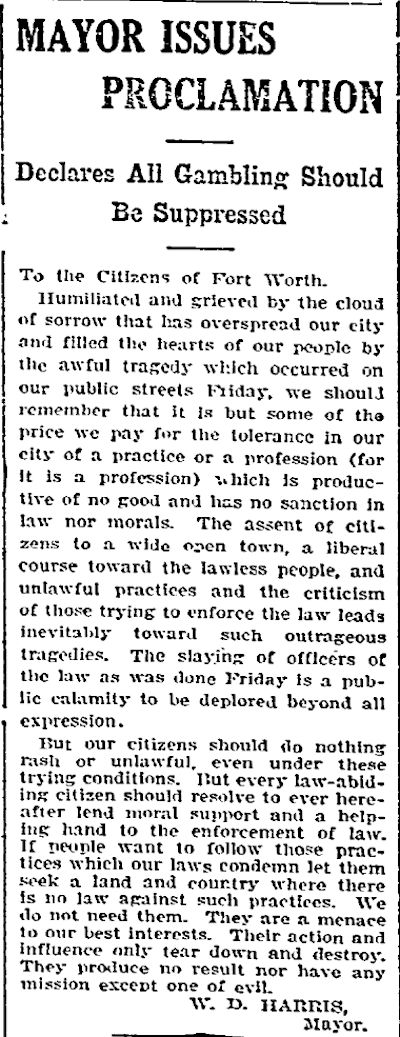 Upon the death of Tarrant County Attorney Jefferson Davis McLean, Mayor W. D. Harris wrote an open letter to the public, saying the city was under a “cloud of sorrow.”
Upon the death of Tarrant County Attorney Jefferson Davis McLean, Mayor W. D. Harris wrote an open letter to the public, saying the city was under a “cloud of sorrow.”
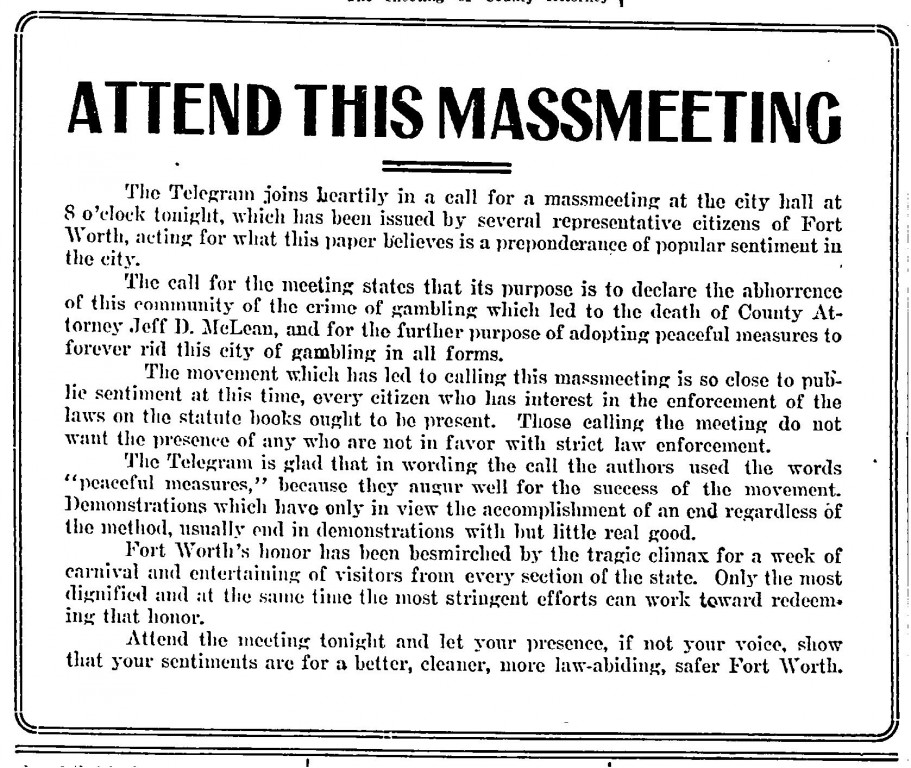 The murder of McLean “besmirched” the honor of Fort Worth and increased public sentiment against gambling, as this Telegram editorial reflects.
The murder of McLean “besmirched” the honor of Fort Worth and increased public sentiment against gambling, as this Telegram editorial reflects.
And the sentiment was not confined to Cowtown. When the shootings occurred, several members of the Texas legislature had been in town for the Stock Show. After they returned to Austin they enacted an anti-gambling law.






Awesome ? Mike Nichols. Thank you.
Thanks, Chris.
I attend Hope Works Church at the corner of Hemphill and Allen. The stained glass windows in the vestibule are dedicated to Jeff McLean, and it appears by his parents. Come see them, they are beautiful.
I have been in that beautiful building and photographed some of its windows (Beatitudes in Brick).
My head’s still spinning from the words “7th and Throckmorton” and “Lumberyard”.
Ha! I suspect we would recognize very little of our city circa 1907.